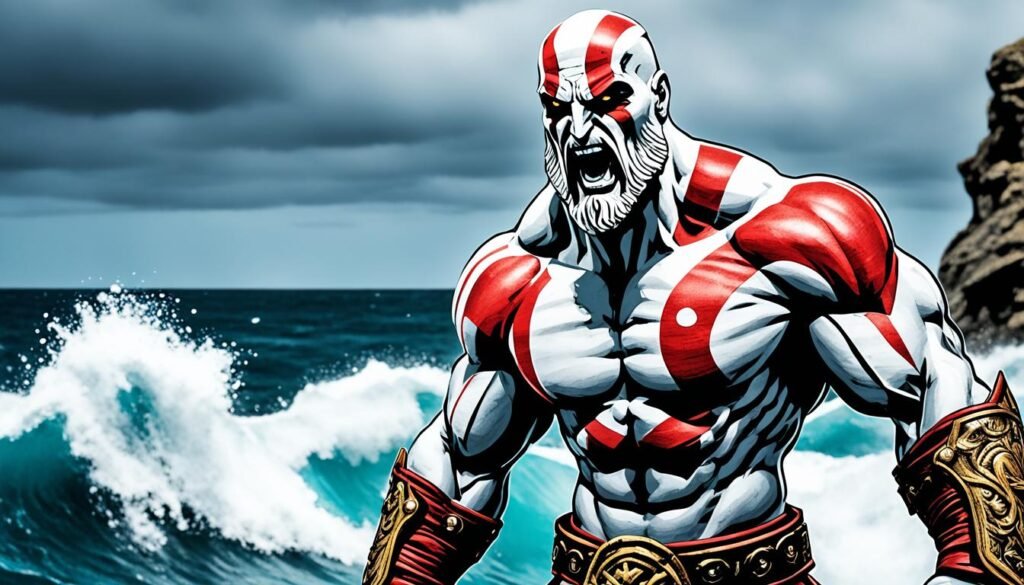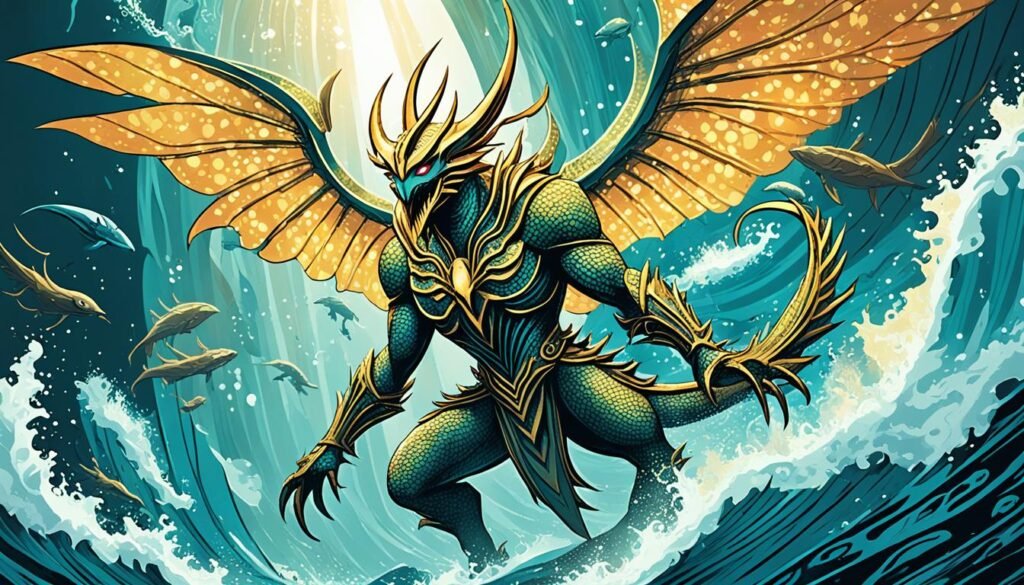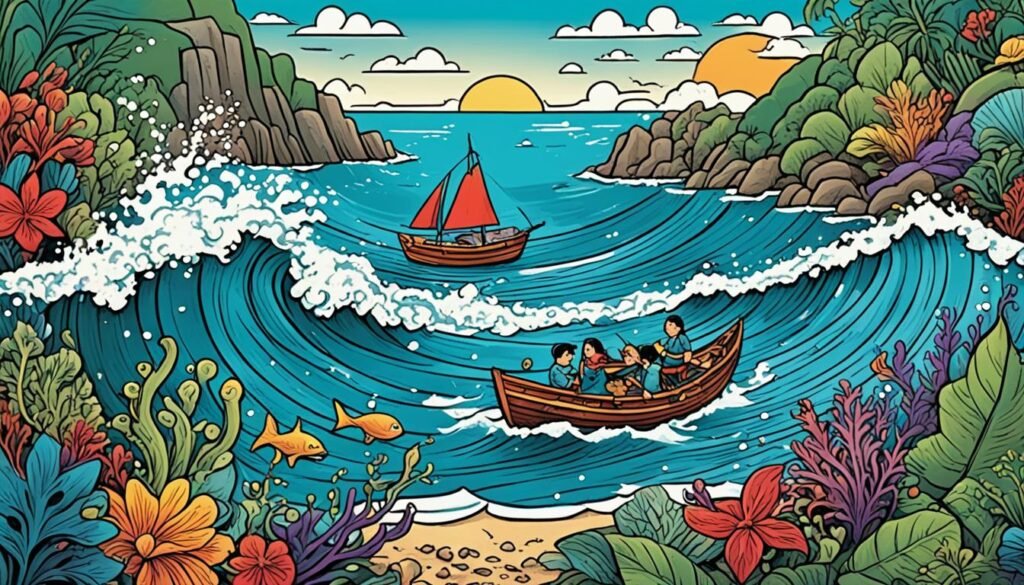In the blue waters of the Philippines, a myth lives on. Kataw, the mermaid, is a key part of Philippine folklore, especially in the Visayas. Stories of creatures under the sea have been told for ages, showing the rich culture of the islands.
In a small village by the sea, elders tell tales by the fire. The story of Kataw would always come up. She was described as part beautiful woman, part fish. These stories intrigued the children, making them eager to learn more about .
Key Takeaways
- Kataw, the mythical mermaid, is a central figure in Philippine folklore, particularly in the Visayas region.
- The captivating tales of Kataw and other mermaid legends have been passed down for generations, reflecting the rich cultural heritage of the Philippines.
- Philippine mythology is a diverse and vibrant tapestry of gods, goddesses, and mythical creatures that are deeply embedded in the daily lives of the Filipino people.
- Oral traditions play a crucial role in preserving and transmitting the essence of Philippine beliefs, values, and identity over centuries.
- Exploring the regional variations and cultural contexts of Philippine mythology provides a deeper understanding of the interconnectedness of Southeast Asian cultures.
Introduction to Philippine Folklore
The Philippines has a rich and varied Philippine mythology. Its tales feature gods, goddesses, and magical beings. These stories have been handed down for ages, part of the country’s Filipino people‘s everyday life. They have helped to keep Philippine beliefs and values alive over generations.
The Rich Tapestry of Philippine Mythology
The Philippine mythology is diverse. It mixes stories from different parts of the country. For instance, the Visayas’ Kataw and the Bicolano’s powerful deities. This Filipino folklore tells fascinating stories that have always intrigued Filipinos.
Significance of Oral Traditions
The use of oral traditions to pass down Philippine mythology shows the Filipino people’s strength. These stories are handed from one generation to another. They keep the core of the country’s beliefs and values alive in the hearts of the Filipino people.
Kataw: The Mythical Mermaid
In the Philippines, the mermaid-like creature known as “kataw” or “sirena” holds a special place. These mythical beings live in the ocean’s deep waters. They are the topic of many stories and tales, especially in the Visayas region.
Kataw is considered a special merfolk in Philippine Mythology. They are ranked higher than other sea creatures like Sirena and Siyokoy. These creatures have human-like faces but feet instead of tails. They also have gills and fins.
Folklore says Kataws can control water in many ways. For example, they can alter tides or change water into ice. They often appear as fishermen. But, they are seeking to lead humans into the ocean to drown them.
Kataw is another name for the Philippine mermaids. In legends, they are also called duyong and manatee. The term Sirena often refers to these Philippine mermaids.
| Mermaid Legends in Philippine Folklore |
|---|
| According to Maximo Ramos, the Visayans call the mermaid kataw, described as a pretty woman from head to waist and a fish with shiny scales below the waist. |
| In the Pavon manuscripts, the catao is described as a large fish-like creature resembling a woman, who sang sad memories in a harmonious voice. |
| Bernabe H. Kapili shared that the word catao in Leyte means ‘likeness of a person’ with a fish tail. |
| In Jesuit Fr. Francisco Ignacio Alzina’s manuscripts, a male and female “catau” (kataw) – merman and mermaid – were depicted. |
In Visayan folklore, various sea creatures relate to kataw. For instance, sharks, rays, and sea stars. A museum in Roxas City, Capiz, also shows a dagger with a kataw design. It was carved by Panay Bukidnon.
“There are connections drawn between Philippine merfolk beliefs and Hindu motifs from the Ramayana epic.”
An encounter with a kataw by a fisherman named Tomas is part of local folklore. It symbolizes mysterious meetings with mermaids.

Regional Variations of Mermaid Legends
The Philippines is known for its varied landscapes and rich cultural customs. These have spawned many local myths about mermaids. In the Visayas, the “Visayan sirena” stands out. It’s a key character in stories, reflecting the ocean-loving way of life there. The Bicolanos, living in Bicol, also have their own mermaid tales. These tales blend with their other mythological beings.
The Visayan Sirena
The Visayan sirena, known as “Magindara” in some places, is seen as dangerous. She leads sailors to their end. Stories about her underline the deep bond between the Visayan community and the sea.
The Bicolano Mermaid Myths
Over in Bicol, the Bicolano mermaid stories mix with tales of other mythical figures. This blend adds rich layers to the region’s folklore. It shows how the culture and land have joined to shape Bicolano folklore.
Apo Laki: God of War and Patron of Salt
In the Philippines, Apo Laki is a well-known deity to the people of Pampango and Pangasinan. He’s tied closely to the sun and seen as a mighty warrior. His story and how he’s worshipped show the varied beliefs that form Filipino heritage.
Origins and Worship in Pampango and Pangasinan
Apo Laki was the pre-colonial era’s god of war and the guardian of salt. People in Pampango and Pangasinan looked up to him. As a representation of the sun, Apo Laki was considered very strong and powerful. He helped his followers through tough times and brought good fortune to their lands.
Apo Laki’s Symbolism and Significance
Apo Laki’s meaning goes deeper than just being a war god. As the salt guardian, people respected him for supporting their daily life needs. His link to the sun highlights life’s endless cycles – birth, death, and renewal, which are key in Filipino myths.
Many people in Pampango and Pangasinan still deeply revere Apo Laki. This reflects the lasting cultural and spiritual beliefs that carry on today. His story highlights the rich mix of Philippine mythologies and the local differences within Filipino culture.

The Bicolano Pantheon
The Bicolano pantheon is full of gods and creatures. It shows the area’s special culture and land. Gugurang is the main god in this group. He is seen as the god of good harvest, wealth, and making things grow.
Gugurang: The Supreme Deity
Gugurang looks like a tall, strong person with silver hair. He controls light, fire, and sometimes lightning. People in Bicol believe he lives in the great Mt. Mayon.
Asuang: The Lord of Darkness
Asuang is the opposite of Gugurang. He stands for darkness and confusion. Asuang brings bad luck, sickness, and natural disasters. He shows the constant fight between good and evil in Bicolano stories.
Handiong and the Epic of Ibalong
The story of Ibalong tells about Handiong, a great warrior. It shows the Bicolanos’ bravery and strength. This story teaches important lessons and shows their cultural values.
Mythical Creatures of Philippine Lore
Beyond the tales of mermaids and deities, Philippine mythology features many mythical beings. These include the nono, or spirits of the elders, and Oryol, a serpentine demigoddess. These beings show the culture and natural world of the Philippines.
Nono: Spirits of the Elders
The “nono” are greatly respected in Philippine culture. They represent the wisdom and traditions of ancestors, helping and guarding the living. Worshipping the nono shows the deep respect Filipinos have for their past and elders’ teachings.
Oryol: The Serpentine Demigoddess
In Bicolano mythology, Oryol is a key figure. As a serpentine demigoddess, her story is part of the Ibalong epic. This shows the lasting impact of Bicolano mythology on Filipino culture.

These creatures, including the nono and Oryol, highlight the Philippines’ rich heritage. Exploring these myths helps us understand the Filipinos’ beliefs, values, and traditions. They are central to their collective identity across the ages.
Cultural Contexts and Linguistic Nuances
The stories of Philippine mythology are often seen through European eyes. This way, they miss the real depth and details. Take, for example, the Bicolanos from Ibalong. They saw some Visayan gods as evil spirits. This shows how complex local and power structures shape their views.
Visayan Gods as Bicolano Demons
Philippine mythology is a mix of cultures and places. This leads to different views on myths. The Bicolanos, for instance, thought of Visayan gods as evil. This shows how beliefs and power make up Bicolano myths differently.
Moving Beyond Eurocentric Interpretations
It’s key to move past only looking at myths through European ideas. This lets us truly see the mix of influences in Philippine myths. Understanding each culture and language helps researchers get to the heart of Philippine folklore.
The Oral Tradition: A Living Narrative
Philippine mythology stands out from Western and European myths. It’s a living narrative shared orally, so stories change over time. This flexibility in oral traditions proves the strength and adaptability of Philippine folklore. It reflects a variety of cultural influences and regional differences, showing the rich imagination of the Filipino people.
Variations and Evolution of Stories
Philippine mythology shines with story variations and story evolution. Passed through oral traditions, stories change with each retelling. These changes, by storytellers adding their unique views, offer many versions across different regions. This process enriches the vast collection of Philippine folklore.

The oral tradition of the Philippines contrasts sharply with the fixed myths in other places. Here, stories are not kept the same. They evolve with each telling, capturing diverse cultural and regional influences. This reflects the depth of the Filipino imagination over many centuries.
Preserving Philippine Mythology
Modern life and the world getting smaller are big challenges for Philippine mythology. People once passed on stories by speaking them, but now we use books and the internet. Bicolano folks, though, keep up festivals and rituals to remember their ancient tales. This helps keep the myths alive for future generations.
Challenges in the Modern Era
Shifting from speaking myths to writing and online sharing is changing things. The stories that were so vibrant and real are struggling to stay the same. They have to fight for attention against today’s movies, games, and vast internet.
The Role of Festivals and Rituals
But the Bicolano people are standing strong, holding onto their festivals and rituals. These festivals are a bridge between now and the old days. They help Filipinos remember where they come from and the amazing stories that define them.
Through these cultural events, the link between the people and their ancient myths stays strong. Participating in these celebrations makes the ancient Philippine mythology a part of daily life. This ensures the stories of old will live on, touching new hearts as time goes by.
Parallels with Hinduism and Buddhism
Philippine mythology shows links to Hinduism and Buddhism, not just European myths. These connections came from trade and cultural interactions with India. This has deeply influenced Filipino stories and beliefs. Understanding these links helps us see how mythologies across Southeast Asia are connected. It also shows how the exchange of ideas has enriched Philippine folklore.
Influence of Indian Culture
Historical trade and sharing with India brought Hinduism and Buddhism to the Philippines. This rich cultural blend is present in Philippine myths and beliefs. It includes parts of Hindu and Buddhist traditions. This mix shows the dynamic nature of cultural blending in the area.
| Parallel Concept | Hinduism | Buddhism | Philippine Mythology |
|---|---|---|---|
| Supreme Deity | Brahma | Buddha | Bathala, Kabuniyan |
| Ancestor Spirits | Pitri | Hungry Ghosts | Ninunò |
| Nature Spirits | Devas | Nagas | Diwata |
| Dualism | Samsara and Moksha | Nirvana and Samsara | Life and Afterlife, Good and Evil |
The connections between Hinduism, Buddhism, and Philippine mythology run deep. They show a history of shared ideas and beliefs. By understanding these links, we see a more complete picture of Philippine folklore.
Linguistic Roots and Cultural Resonances
In Philippine myths, the names of gods and goddesses hold deep cultural and linguistic meaning. Translating them to English loses these rich cultural connections. It’s key to understand these mythical names for an authentic look into Philippine stories. This shows how language, culture, and imagination are tied in the Filipino world.
Significance of Mythological Names
In Bicolano myths, deities like Gugurang and Asuang stand out. Their names reflect the Bicolano culture and language. By digging into the Bicolano pantheon, we get a glimpse into their beliefs and stories. This unveils the beauty of Philippine folklore.
Names like Oryol and “nono” show another layer of the story. They can’t fully translate into English. These names open doors to longstanding tales and beliefs, highlighting the Filipino’s unique culture and traditions.
Understanding these names’ linguistic and cultural meanings is crucial. It helps scholars and fans see the richness of Philippine mythology. By doing this, we avoid seeing things through a European lens and appreciate the local view more.
Conclusion
The legends of Kataw, the mythical mermaid, are just a piece of Philippine mythology‘s big story. This article talked about mermaid myths from various areas, the gods of Bicol, and how culture and language affect these tales. We also saw connections to Hinduism and Buddhism. And we discussed the fight to keep these stories alive today.
Kataw’s story is special because it shows the many faces of Philippine mythology. These stories are old but still fascinate us today. They show the strength and creativity of the Filipino culture. It’s important to keep these myths alive. They connect us to our past and shape our future.
Learning about Philippine mythology is more than hearing old stories. It helps us understand who the Filipino people are. These stories, unique in each region, show the power of imagination and the resilience of the Philippines. They’re a precious part of our heritage, uniting us with our ancestors as we move forward.
FAQ
What is Kataw, the mythical mermaid, and its significance in Philippine folklore?
What is the significance of oral traditions in Philippine mythology?
How do the regional variations of mermaid legends across the Philippines reflect the country’s diverse cultural heritage?
Who is Apo Laki, and what is his significance in Philippine mythology?
What are the key figures and narratives in the Bicolano pantheon?
What are some of the other mythical creatures found in Philippine folklore, and what do they represent?
How do Eurocentric interpretations often fail to capture the nuances of Philippine mythology?
How does the fluid nature of Philippine mythology differ from the more standardized mythologies found in Western and European cultures?
What challenges do the preservation of Philippine mythology face in the modern era, and how do cultural celebrations play a role in maintaining its vitality?
What are the parallels between Philippine mythology and the belief systems of Hinduism and Buddhism, and how do they contribute to a deeper understanding of these narratives?
How do the linguistic roots and cultural resonances of mythological names in Philippine folklore contribute to a more nuanced understanding of these captivating narratives?
Source Links
- http://bicolanomythsofgodsandmonsters.blogspot.com/2016/09/bicolano-pantheon.html
- https://www.kollectivehustle.com/blog/kapreandaswang-filipino-mythology-for-beginners
- https://journals.upd.edu.ph/index.php/humanitiesdiliman/article/download/9461/8361/
- https://en.wikipedia.org/wiki/Kataw_(Philippine_mythology)
- https://www.aswangproject.com/kataw-mermaids-of-the-visayas/
- https://en.wikipedia.org/wiki/Sirena_(Philippine_mythology)
- https://en.wikipedia.org/wiki/Anito
- https://philippine-media.fandom.com/wiki/List_of_Philippine_mythological_figures
- https://en.wikipedia.org/wiki/List_of_Philippine_mythological_creatures
- https://www.deviantart.com/bdy/journal/The-Forgotten-Gods-Goddesses-and-Heroes-of-Philip-240076359
- https://jacoblaneria.wordpress.com/2020/06/26/towards-filipino-film-noir-notes-on-smaller-and-smaller-circles-raya-martin-2017/
- https://philippine-media.fandom.com/wiki/Philippine_folk_literature
- https://www.tatlerasia.com/lifestyle/arts/trese-quick-guide-on-the-monsters-of-philippine-folklore
- https://philippine-media.fandom.com/wiki/Indigenous_Philippine_folk_religions
- https://www.studocu.com/ph/document/caraga-state-university/bsed-biology/da-adventures-of-pedro-penduko/79450378

